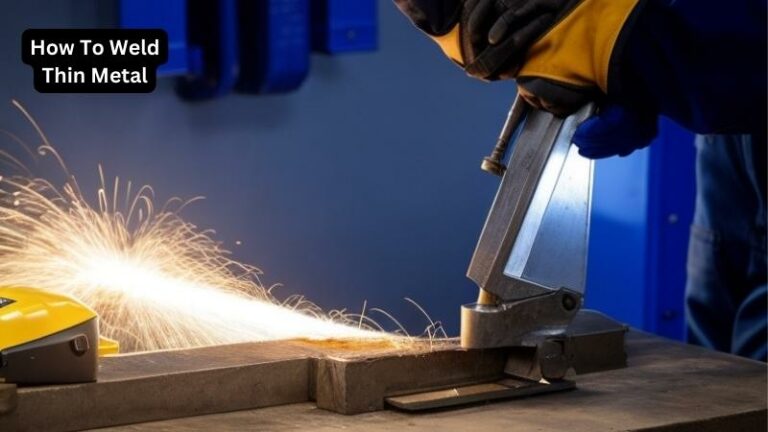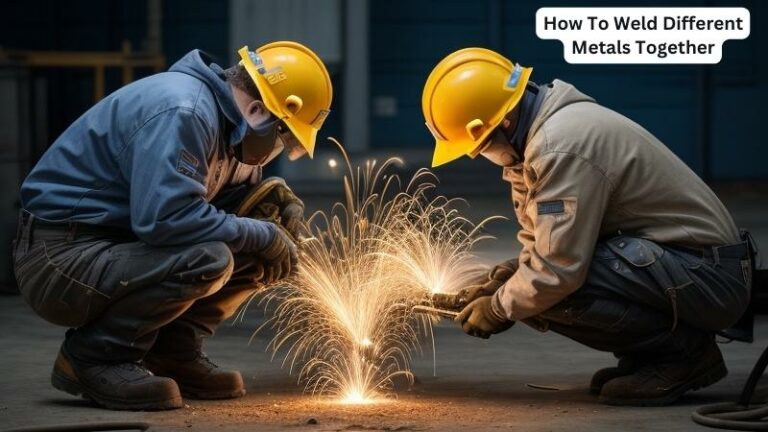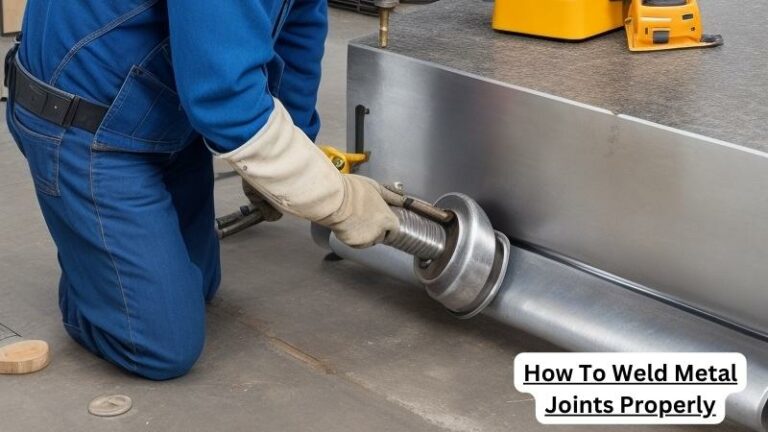How To Weld A Joint
So you want to learn How To Weld A Joint? Well, you’ve come to the right place! Welding is an incredibly useful skill that can open up a world of possibilities. Whether you want to build your own metal sculptures, repair broken parts, or even create custom furniture, knowing how to weld can come in handy in so many ways.
But hold on there, what exactly is welding? In simple terms, welding is the process of joining two or more pieces of metal together using heat. It’s like using a hot glue gun, but for metal! By melting and fusing the metals, we can create strong and durable connections that can withstand all sorts of forces.
Now, you might be wondering, how do I get started with welding? Don’t worry, we’ve got you covered. In this guide, we’ll walk you through the basics of welding, from the equipment you’ll need to the step-by-step process of creating a solid weld. So grab your safety goggles, put on your welding gloves, and let’s dive into the exciting world of welding!
How to Weld a Joint: A Comprehensive Guide
Welding is a fundamental process in metalwork that involves joining two or more pieces of metal together by melting and fusing them. When it comes to creating strong and durable joints, welding is the go-to method for countless applications in industries such as construction, automotive, and manufacturing.
In this article, we will provide you with a comprehensive guide on how to weld a joint, covering everything from the types of joints to the necessary equipment and techniques. So, if you’re ready to dive into the world of welding, let’s get started!
The Basic Types of Joints:
Before we delve into the welding process, it’s important to understand the different types of joints you may encounter. Each joint has its own purpose and specific requirements for welding. Here are the most common types of joints used in metalwork:
1. Butt Joint: This is the simplest and most common joint, where two pieces of metal are aligned in the same plane and welded along the edge.
2. Corner Joint: As the name suggests, this joint is formed by joining two pieces of metal at a right angle.
3. Lap Joint: In a lap joint, one piece of metal overlaps the other, creating a joint with increased strength and surface area for welding.
4. T-Joint: This type of joint is formed when two pieces of metal intersect at a perpendicular angle, resembling the letter “T.”
5. Edge Joint: An edge joint involves joining two pieces of metal along their edges, typically used for thin materials or sheet metal.
Preparing the Joint for Welding:
Proper preparation is crucial in achieving a strong and durable weld. Here are the steps to prepare the joint for welding:
1. Clean the metal: Before starting the welding process, ensure that the surfaces to be welded are clean and free from any contaminants like dirt, rust, or paint. Use a wire brush or grinder to remove any impurities.
2. Bevel the edges (if necessary): For certain joints, like butt joints, it may be necessary to bevel or chamfer the edges to create a V-shaped groove. This allows for better penetration of the weld and stronger bonding.
3. Clamp the pieces together: Secure the pieces of metal in the desired position using clamps or magnets. This ensures that they remain stable and aligned during the welding process.
4. Tack weld: Before proceeding with the final weld, it is advisable to perform tack welding. Tack welds are small, temporary welds that hold the joint together, allowing you to make any necessary adjustments before committing to the final weld.
Choosing the Right Welding Technique
Several welding techniques can be used to join metal pieces together. The choice of technique depends on factors such as the type of joint, the thickness of the metal, and the desired strength of the weld. Here are three commonly used techniques:
1. MIG Welding: Also known as Metal Inert Gas welding, MIG welding is an efficient method that uses a continuous wire as the filler material and a shielding gas to protect the weld from contamination. It is versatile and suitable for a wide range of materials, including steel, aluminum, and stainless steel.
2. TIG Welding: Tungsten Inert Gas welding, or TIG welding, is a precise and clean welding process that produces high-quality welds. It uses a non-consumable tungsten electrode, a filler rod, and a shielding gas. TIG welding is often preferred for thin materials and critical applications where aesthetics and precision are important.
3. Stick Welding: Also known as Shielded Metal Arc Welding (SMAW), stick welding is a traditional and versatile welding technique that is widely used in construction projects. It involves using a consumable electrode coated in flux to create the weld, and it can be used on a variety of metals, including steel, iron, and cast iron.
Equipment and Safety Precautions:
To weld a joint effectively and safely, you’ll need the right equipment and take the necessary safety precautions. Here’s what you’ll need:
1. Welding machine: Select a welding machine suitable for your chosen welding technique. Consider factors such as input power, duty cycle, and amperage range.
2. Welding electrode or wire: Depending on the welding technique, you’ll need the appropriate filler material, such as welding electrodes or a spool of welding wire.
3. Shielding gas: If you’re using a process like MIG welding, you’ll need a suitable shielding gas, such as argon or a mixture of argon and carbon dioxide.
4. Personal protective equipment (PPE): Always prioritize safety when welding. Wear a welding helmet, safety glasses, welding gloves, and appropriate clothing to protect yourself from sparks, fumes, and UV radiation.
5. Ventilation: Welding produces hazardous fumes and gases. Ensure you’re working in a well-ventilated area or use an exhaust system to remove the fumes.
Remember to follow all safety guidelines and consult the manufacturer’s instructions for your specific equipment.
Benefits of Welding Joints:
Welding joints offer several benefits compared to other joining methods like bolting or riveting. Here are some advantages of welding joints:
1. Strength and durability: Welded joints have excellent strength and can withstand heavy loads and stress, making them ideal for structural applications.
2. Aesthetics: Welded joints provide a seamless appearance as the filler material fuses with the base metal.
3. Versatility: Welding can be used on a wide range of materials, including steel, aluminum, stainless steel, and more.
4. Reduced weight: Welding allows for the use of thinner materials, resulting in lighter structures without compromising strength.
5. Cost-effective: Welding eliminates the need for additional fasteners and reduces assembly time, resulting in cost savings.
Common Challenges and Tips for Successful Welding:
While welding can be a rewarding skill to master, it comes with its own set of challenges. Here are some common challenges faced during the welding process and tips to overcome them:
1. Welding distortion: Heat generated during welding can cause the metal to expand and contract, leading to distortion. To minimize distortion, use proper tack welds, distribute heat evenly, and consider using techniques like backstepping.
2. Porosity: Porosity refers to the presence of gas pockets or voids in the weld. To avoid porosity, ensure the base metal is clean, use the correct shielding gas, and maintain a proper welding technique.
3. Lack of fusion: Lack of fusion occurs when the weld does not bond properly with the base metal. It can be caused by improper heat settings, inadequate cleaning, or incorrect welding techniques. Ensure proper surface preparation, maintain proper heat settings, and practice proper welding techniques to achieve good fusion.
4. Cracking: Cracks can occur in the weld due to issues like thermal stress or improper welding technique. Use preheating techniques when necessary, control cooling rates, and select appropriate filler materials to minimize the risk of cracking.
5. Practice, practice, practice: Welding is a skill that requires practice to achieve proficiency. Remember that success in welding comes with experience, so make sure to practice different techniques, materials, and joint types.
With these tips in mind, you’ll be well on your way to mastering the art of welding and creating strong, reliable joints.
Important Safety Considerations:
While welding can be a rewarding and satisfying skill to develop, it’s crucial to prioritize safety at all times. Here are some important safety considerations when welding:
1. Ventilation: Ensure you are working in a well-ventilated area to avoid inhalation of hazardous fumes and gases. If working indoors, use mechanical ventilation or consider using a fume extractor.
2. Eye and face protection: Always wear a welding helmet with the appropriate shade for the welding process you are using. Additionally, wear safety glasses with side shields to protect your eyes from sparks and flying debris.
3. Clothing and skin protection: Wear flame-resistant clothing and leather welding gloves to protect your skin from burns and other thermal hazards. Avoid wearing synthetic materials that can melt or catch fire.
4. Fire prevention: Keep a fire extinguisher nearby and ensure you are working in an environment free from flammable materials. Remove all potential ignition sources and create a fire-safe zone around your welding area.
5. Electric shock: Ensure proper grounding of your welding equipment and do not touch live electrical parts. Avoid wet environments and use insulated tools to minimize the risk of electric shock.
Remember, safety should always be your number one priority when working with welding equipment and processes. Take the time to familiarize yourself with the safety guidelines provided by the equipment manufacturer and follow them diligently.
Key Takeaways: How To Weld A Joint
- Welding a joint requires proper safety gear, such as a welding mask and gloves.
- Clean the metal surfaces to be welded before starting, removing any dirt, rust, or paint.
- Choose the right welding method based on the type of metal and the joint you are working on.
- Position the metal pieces to be welded properly, ensuring a secure fit and alignment.
- Start the welding process by striking an arc and maintaining a steady motion along the joint.
faqs for How To Weld A Joint:
Welding a joint serves the purpose of permanently joining two or more metal parts together. It creates a strong, durable bond that can withstand high-stress and load-bearing applications. Whether you’re working on a construction project or repairing broken metal components, welding allows you to create a solid connection that can last for years.
Various types of welding joints, such as butt joints, lap joints, and T-joints, serve different purposes depending on the specific application. By welding joints, you can ensure structural integrity, improve efficiency, and enhance the overall performance of metal assemblies.
When it comes to welding, safety should always be a top priority. Here are a few essential precautions to keep in mind:
First, make sure you’re working in a well-ventilated area to avoid inhaling harmful fumes. Wear appropriate personal protective equipment, including a welding helmet, gloves, and flame-resistant clothing.
Additionally, ensure the work surface is clean and free from flammable materials. Keep a fire extinguisher nearby and have a first aid kit readily available. Following these safety measures will help minimize the risk of accidents and ensure a safe welding experience.
There are several welding techniques commonly used to weld joints. Some of the most widely used techniques include:
1. MIG welding (Metal Inert Gas welding): This technique uses a wire electrode and an inert gas, such as argon, to create a weld.
2. TIG welding (Tungsten Inert Gas welding): TIG welding uses a tungsten electrode and a shielding gas to form the weld. It is known for producing high-quality and precise welds.
3. Arc welding: Also known as stick welding, this technique uses an electric arc to join metals together.
Each technique has its advantages and is suitable for different types of metals and applications. It’s important to choose the right technique based on your specific welding requirements.
Welding joints may pose certain challenges that require careful consideration and skill. Some common challenges include:
1. Distortion: The heat generated during welding can cause the metal to expand and contract, resulting in distortion or warping of the joint. Proper welding techniques, such as using clamps or heat sinks, can help minimize distortion.
2. Weld defects: Welding may sometimes lead to defects like cracks, porosity, or incomplete fusion. Ensuring proper welding parameters, clean surfaces, and adequate filler material can help reduce such defects.
By being aware of these challenges and employing appropriate techniques and precautions, you can overcome them and achieve high-quality welds.
Becoming proficient in welding joints requires practice and continuous improvement. Here are a few tips to enhance your welding skills:
1. Seek proper training: Enroll in a welding course or seek guidance from experienced welders to learn the fundamentals and gain valuable knowledge.
2. Practice regularly: Set aside dedicated time to practice welding joints. The more you practice, the better you’ll become at controlling the heat, managing the arc, and achieving clean welds.
3. Analyze your welds: Examine your welds critically to identify areas of improvement. Look for any defects or inconsistencies and work on addressing them.
Remember, patience and perseverance are key when it comes to developing your welding skills. With time and effort, you can become a proficient welder capable of creating strong and reliable joints.
Fillets Welds | Multi-pass 7018 All the Way Out
Summary
So, you want to know how to weld a joint? Well, here’s what you need to remember. First, make sure you have the right safety gear like goggles and gloves. Then, clean the metal surfaces before welding to ensure a strong bond. Next, position the pieces to be welded at the right angle and use clamps to hold them in place. Now, it’s time to choose the right welding technique for the job, whether it’s MIG, TIG, or stick welding. Remember to maintain a steady hand and move in a controlled manner. Lastly, let the weld cool down and inspect it for any imperfections, and you’re done!



